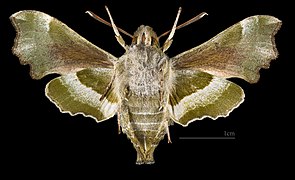Willowherb hawkmoth
Appearance
| Willowherb hawkmoth | |
|---|---|

| |
| Scientific classification | |
| Domain: | Eukaryota |
| Kingdom: | Animalia |
| Phylum: | Arthropoda |
| Class: | Insecta |
| Order: | Lepidoptera |
| Family: | Sphingidae |
| Genus: | Proserpinus |
| Species: | P. proserpina
|
| Binomial name | |
| Proserpinus proserpina | |

| |
| Synonyms | |
| |
The willowherb hawkmoth (Proserpinus proserpina) is a moth in the family Sphingidae. The species was first described by Peter Simon Pallas in 1772.
Distribution
[edit]It is found in Armenia, Austria, Azerbaijan, Belgium, Bulgaria, Denmark, France, Germany, Greece, Hungary, Iran, Iraq, Israel, Italy, Kazakhstan, Lebanon, Morocco, Netherlands, Portugal, Poland Spain, Switzerland, Syria, Turkey, Turkmenistan, Ukraine, Uzbekistan, and Bosnia and Herzegovina.[1]
Description
[edit]-
Caterpillar
-
Proserpinus proserpina ♂
-
Proserpinus proserpina ♂ △
-
Proserpinus proserpina ♀
-
Proserpinus proserpina ♀ △
Biology
[edit]The larvae feed on Epilobium (including Epilobium hirsutum), Oenothera and Lythrum species.
References
[edit]- ^ a b World Conservation Monitoring Centre (1996). "Proserpinus proserpina". IUCN Red List of Threatened Species. 1996: e.T18366A8153516. doi:10.2305/IUCN.UK.1996.RLTS.T18366A8153516.en. Retrieved 18 November 2021.
- ^ "CATE Creating a Taxonomic eScience - Sphingidae". Cate-sphingidae.org. Archived from the original on 2012-11-05. Retrieved 2011-10-26.
- ^ Pittaway, A. R. (2018). "Proserpinus Hübner, [1819]". Sphingidae of the Western Palaearctic. Retrieved December 13, 2018.
External links
[edit]Wikimedia Commons has media related to Proserpinus proserpina.






